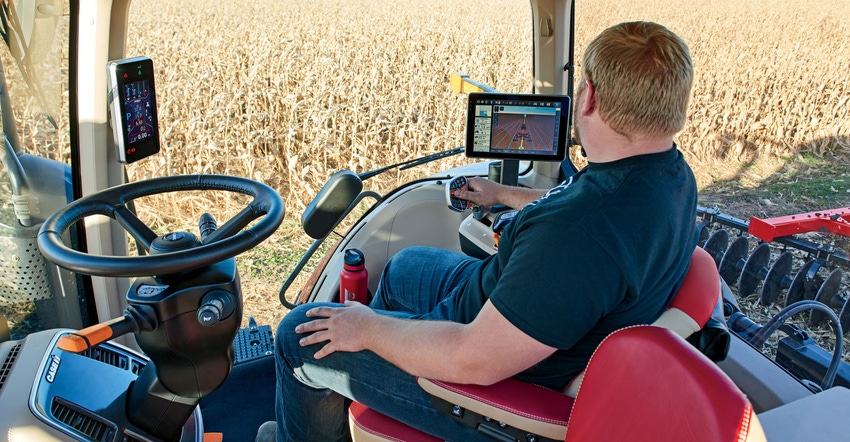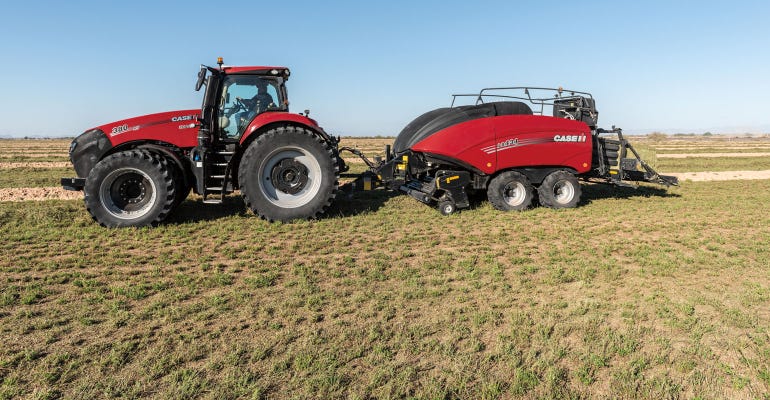March 26, 2021

Leo Bose has been immersed in precision agriculture technology since 1994. “I remember installing the first GPS device on a Case IH combine,” he said. Bose is the Case IH AFS marketing manager lead, and for 2021 he’s enthused about what the company is offering farmers. During Commodity Classic, Bose and his colleague Kirk Wesley, AFS marketing manager, shared news of the first major update of AFS Connect Farm software, including a new mobile app.
“You can carry your farm in your pocket with this new app,” Wesley said.
The system adds significant new capabilities for analyzing information, support for prescriptions and large square balers, new layer visualizations and machine utilization maps. After Commodity Classic, Case IH launched a virtual event where Bose and Wesley shared more information about the system, including a story from Nick Welker, Shelby, Mont. Case IH has partnered with Welker Farms, the Montana operation that’s built a solid reputation for sharing information, and more, on its YouTube channel.
 MAXIMIZING BALES: The AFS Connect Farm app can track where the large square baler drops each bale. The system includes several features of the bale including wet and dry weight, moisture percentage, density, capacity and flakes per bale. Farmers using the system could then sort bales by quality for different uses.
MAXIMIZING BALES: The AFS Connect Farm app can track where the large square baler drops each bale. The system includes several features of the bale including wet and dry weight, moisture percentage, density, capacity and flakes per bale. Farmers using the system could then sort bales by quality for different uses.

During the virtual event, Welker shared a surprise he found when he looked at his farm’s information in AFS Connect. “Our use of data management is growing,” Welker said. “It’s been a slow transition; we’re in a dry climate, and we have a lot of acres. Last year, we transmitted our data to the cloud through the AFS Connect portal. We got some surprises, and some that were stomach-turning.”
Welker shared a map during the online event, showing significant yield losses on field edges. It turns out on chem fallow acres — a common practice in the region — drift from that land was hitting wheat fields. He noted the farm is working away from the use of chem fallow, and that may be accelerated by what he found in his analysis.
“We want to prevent mistakes from 2020 in 2021,” he said. The chem fallow drift, where it showed up in yield maps, hit yields hard. Welker said in fields with yield averages of 40 to 50 bushels per acre, those drift-hit areas saw yields in the teens.
“This showed the damage that was done,” Welker shared. “We’ll tackle that differently this year.”
The value of information
Farm Progress talked with Wesley and Bose from Case IH soon after the virtual event.
Noting Welker’s presentation from the virtual event, Wesley commented: “I honestly think [that information Welker found] was something he realized shocked him. You see what’s going on, but I think it’s a great opportunity for him to start thinking about what he’s doing and where he’s going.”
 CONNECTED BALER: Often when you think of yield data from equipment, you don’t think “large square baler,” but the updated AFS Connect Farm software now allows information capture from these machines.
CONNECTED BALER: Often when you think of yield data from equipment, you don’t think “large square baler,” but the updated AFS Connect Farm software now allows information capture from these machines.

As for that AFS Connect software update? Bose and Wesley walked through a demonstration showing what farmers can get by signing up for the system. “We can connect those vehicles, whether it’s a Magnum, Steiger, a 250-series combine or a Patriot sprayer,” Bose said. “Now we’ve got a gateway of that data the customer can take and use.”
Bose added that the telematics for AFS Connect be set up on machines dating as far back as 2010. “What you need is what we call a telematics device, a P&CM (productivity and connectivity module), and then an advanced subscription and you can take advantage of [these tools],” he explains.
The new mobile app brings more power to look at collected data, too. “They’ve got a gateway right to their farm in the palm of their hand,” Bose said. The app is designed to work with smartphone or tablet; it’s a significant upgrade for Case IH.
Late in 2019, Case IH acquired AgDNA, a connected farm management information system. This acquisition helped the company launch AFS Connect in early 2020. Building on that acquisition, as well as the tech the company has been refining since 1994, powers this latest full-tech upgrade.
Bose noted that with the system, it’s possible to capture data from all equipment on the system, track those machines at work in the field — in real time — and share information with trusted advisers as needed.
Maximizing data use
One feature, or data approach, Case IH has taken is to manage data by field boundaries. Wesley noted that the flood of data coming to a farm from machines on the farm, custom services, scouts and more can be challenging to manage. “The great thing about this software, based on field boundaries: We track what activities are going to take place,” Wesley said.
He noted that once the field boundary is in the system, the system keeps track of where the data belongs. If an operator forgets to enter the field name into the system before starting a task on that field, the software knows where the event took place and records it properly. “[The software] will automatically separate all this out in that geospatial sorting, and put the information into the proper fields,” Wesley added.
Here’s a look at other enhancements in the AFS Connect Farm update.
Enhanced mobile app user interface. The updated AFS Connect Farm app allows users access to a wide range of field information when they select a map from the main screen. With a few taps, users can view field-specific data including activity layers, scouting observations and soil zone data. And field- and vehicle-specific data is more accessible.
“When you look at mobile apps, that's where our customers seem to want the most new features,” Bose added.
Prescription creation. You can maximize AFS Soil Command with an all-new prescription creation tool. This allows you to customize equipment settings to match conditions in different areas of the field while on the go.
Large baler support. This feature may surprise producers, but the idea came from farmers. Users of large balers can see data import and display activity layers in the app, and even see specific bale-drop location. It’s possible to identify different bales by key quality factors. Information includes wet and dry weight, moisture percentage, density, capacity and flakes per bale.
Wesley noted that this knowledge has value to customers, explaining that this information allows a producer to sort bales into different quality levels from that field to meet specific market needs. “The horse guys are going to love this,” Wesley said.
Farmers can sign up for this service for free to test it out. Visit mycaseih.com, enter some basic information and you can set up an account.
About the Author(s)
You May Also Like






